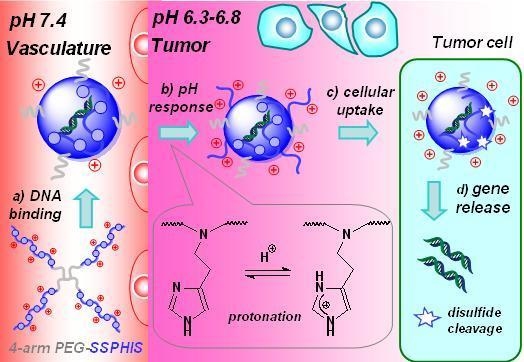A pH and Redox Dual Responsive 4-Arm Poly(ethylene glycol)-block-poly(disulfide histamine) Copolymer for Non-Viral Gene Transfection in Vitro and in Vivo
Abstract
:1. Introduction
2. Results and Discussion
2.1. Synthesis and Characterization of 4-Arm PEG-Conjugated Bioreducible Poly(disulfide histamine)
2.2. Biophysical Properties of the Polyplexes of 4-Arm PEG-SSPHIS
2.3. 4-Arm PEG-SSPHIS Induces Efficient Gene Transfection in HepG2 Cancer Cells in Vitro
2.4. Transgene Expression Induced by Polyplexes of 4-Arm PEG-SSPHIS in HepG2 Tumor
3. Experimental Section
3.1. Materials
3.2. Synthesis of 4-Arm PEG-block-poly(disulfide histamine) (4-Arm PEG-SSPHIS) Copolymer
3.3. Chemical and Biophysical Characterization
3.4. Agarose Gel Electrophoresis Assay
3.5. Cell Culture and Gene Transfection in Vitro
3.6. Cytotoxicity Assay of 4-Arm PEG-SSPHIS
3.7. In Vivo Gene Transfection in HepG2 Tumor Bearing in Nude Mice
3.8. Statistical Analysis
4. Conclusions
Acknowledgments
Conflicts of Interest
- Author ContributionsKangkang An and Peng Zhao perform synthesis, characterization and experiments. Chao Lin contributes idea of this paper. The authors wrote manuscript, data analysis and result discussions.
References
- Anderson, W.F. Human gene therapy. Nature 1998, 392, 25–30. [Google Scholar]
- Thomas, C.E.; Ehrhardt, A.; Kay, M.A. Progress and problems with the use of viral vectors for gene therapy. Nat. Rev. Genet 2003, 4, 346–358. [Google Scholar]
- Verma, M.; Somia, N. Gene therapy—Promises, problems and prospects. Nature 1997, 389, 239–242. [Google Scholar]
- Li, S.; Huang, L. Non-viral gene therapy: Promises and challenges. Gene Ther 2000, 7, 31–34. [Google Scholar]
- Merdan, T.; Kopecek, J.; Kissel, T. Prospects for cationic polymers in gene and oligonucleotide therapy against cancer. Adv. Drug Deliv. Rev 2002, 54, 715–758. [Google Scholar]
- Anwer, K.; Rhee, B.G.; Mendiratta, S.K. Recent progress in polymeric gene delivery systems. Crit. Rev. Ther. Drug Carr. Syst 2003, 20, 249–293. [Google Scholar]
- Pack, D.W.; Hoffman, A.S.; Pun, S.; Stayton, P.S. Design and development of polymers for gene delivery. Nat. Rev. Drug Discov 2005, 4, 589–593. [Google Scholar]
- Boussif, O.; Lezoualch, F.; Zanta, M.A.; Mergny, M.D.; Scherman, D.; Demeneix, B.; Behr, J.P. A versatile vector for gene and oligonucleotide transfer into cells in culture and in vivo: Polyethylenimine. Proc. Natl. Acad. Sci. USA 1995, 92, 7297–7301. [Google Scholar]
- Luten, J.; van Nostruin, C.F.; de Smedt, S.C.; Hennink, W.E. Biodegradable polymers as non-viral carriers for plasmid DNA delivery. J. Control. Release 2008, 126, 97–110. [Google Scholar]
- Cheng, R.; Feng, F.; Meng, F.H.; Deng, C.; Feijen, J.; Zhong, Z.Y. Glutathione-responsive nano-vehicles as a promising platform for targeted intracellular drug and gene delivery. J. Control. Release 2011, 152, 2–12. [Google Scholar]
- Lin, C.; Engbersen, J.F.J. The role of the disulfide group in disulfide-based polymeric gene carriers. Expert Opin. Drug Deliv 2009, 6, 421–439. [Google Scholar]
- Son, S.; Namgung, R.; Kim, J.; Singha, K.; Kim, W.J. Bioreducible polymers for gene silencing and delivery. Acc. Chem. Res 2012, 45, 1100–1112. [Google Scholar]
- Lin, C.; Zhong, Z.; Lok, M.C.; Jiang, X.; Hennink, W.E.; Feijen, J.; Engbersen, J.F.J. Novel bioreducible poly(amido amine)s for highly efficient gene delivery. Bioconjate Chem 2007, 18, 138–145. [Google Scholar]
- Lin, C.; Blaauboer, C.-J.; Timoneda, M.M.; Lok, M.C.; van Steenbergen, M.; Hennink, W.E.; Feijen, J.; Zhong, Z.Y.; Engbersen, J.F.J. Bioreducible poly(amido amine)s with oligoamine side chains: Synthesis, characterization, and structural effect on gene delivery. J. Control. Release 2008, 126, 166–174. [Google Scholar]
- Brumbach, J.H.; Lin, C.; Yockman, J.; Kim, W.J.; Blevins, K.S.; Engbersen, J.F.J.; Feijen, J.; Kim, S.W. Mixtures of poly(triethylenetetramine/cystamine bisacrylamide) and poly(triethylenetetramine/cystamine bisacrylamide)-g-poly(ethylene glycol) for improved gene delivery. Bioconjate Chem 2010, 21, 1753–1761. [Google Scholar]
- Wiethoff, C.M.; Middaugh, C.R. Barriers to nonviral gene delivery. J. Pharm. Sci 2003, 92, 203–217. [Google Scholar]
- Nishikawa, M.; Huang, L. Nonviral vectors in the new millennium: Delivery barriers in gene transfer. Nucleic Acid Res 2001, 12, 861–870. [Google Scholar]
- Plank, C.; Mechter, K., Jr.; F.C.S.; Wagner, E. Activation of the complement system by synthetic DNA complex: A potential barrier for intravenous gene delivery. Hum. Gene Ther 1996, 7, 1437–1446. [Google Scholar]
- Lin, C.; Engbersen, J.F.J. PEGylated bioreducible poly(amido amine)s for non-viral gene delivery. Mater. Sci. Eng. C 2011, 31, 1330–1337. [Google Scholar]
- Mishra, S.; Webster, P.; Davis, M.E. PEGylation significantly affects cellular uptake and intracellular trafficking of non-viral gene delivery particles. Eur. J. Cell Biol 2004, 83, 97–111. [Google Scholar]
- Hatakeyama, H.; Akita, H.; Harashima, H. A multifunctional envelope type nano device (MEND) for gene delivery to tumours based on the EPR effect: A strategy for overcoming the PEG dilemma. Adv. Drug Deliv. Rev 2011, 63, 152–160. [Google Scholar]
- Tian, L.; Bae, Y.H. Cancer nanomedicines targeting tumor extracellular pH. Colloids Surf. B 2012, 99, 116–126. [Google Scholar]
- Cheng, J.; Zeidan, R.; Mishra, S.; Liu, A.; Pun, S.H.; Kulkarni, R.P.; Jensen, G.S.; Bellocq, N.C.; Davis, M.E. Structure-Function correlation of chloroquine and analogues as transgene expression enhancers in nonviral gene delivery. J. Med. Chem 2006, 49, 6522–6531. [Google Scholar]
- Knorr, V.; Allmendinger, L.; Walker, G.F.; Paintner, F.F.; Wagner, E. An acetal-based PEGylation reagent for pH-Sensitive shielding of DNA polyplexes. Bioconjate Chem 2007, 18, 1218–1225. [Google Scholar]
- Knorr, V.; Ogris, M.; Wagner, E. An acid sensitive ketal-Based polyethylene glycol-oligoethylenimine copolymer mediates improved transfection efficiency at reduced toxicity. Pharm. Res 2008, 25, 2937–2945. [Google Scholar]
- Zou, S.M.; Erbacher, P.; Remy, J.S.; Behr, J.P. Systemic linear polyethylenimine(L-PEI)-mediated gene delivery in the mouse. J. Gene Med 2000, 2, 128–134. [Google Scholar]
- Lin, C.; Zhao, P.; Li, F.; Guo, F.; Li, Z.; Wen, X. Thermosensitive in situ-forming dextran-pluronic hydrogels through Michael addition. Mater. Sci. Eng. C 2010, 30, 1236–1244. [Google Scholar]
- Lin, C.; Song, Y.; Lou, B.; Zhao, P. Dextranation of bioreducible cationic polyamide for systemic gene delivery. Bio-Med. Mater. Eng 2014, 24, 673–682. [Google Scholar]
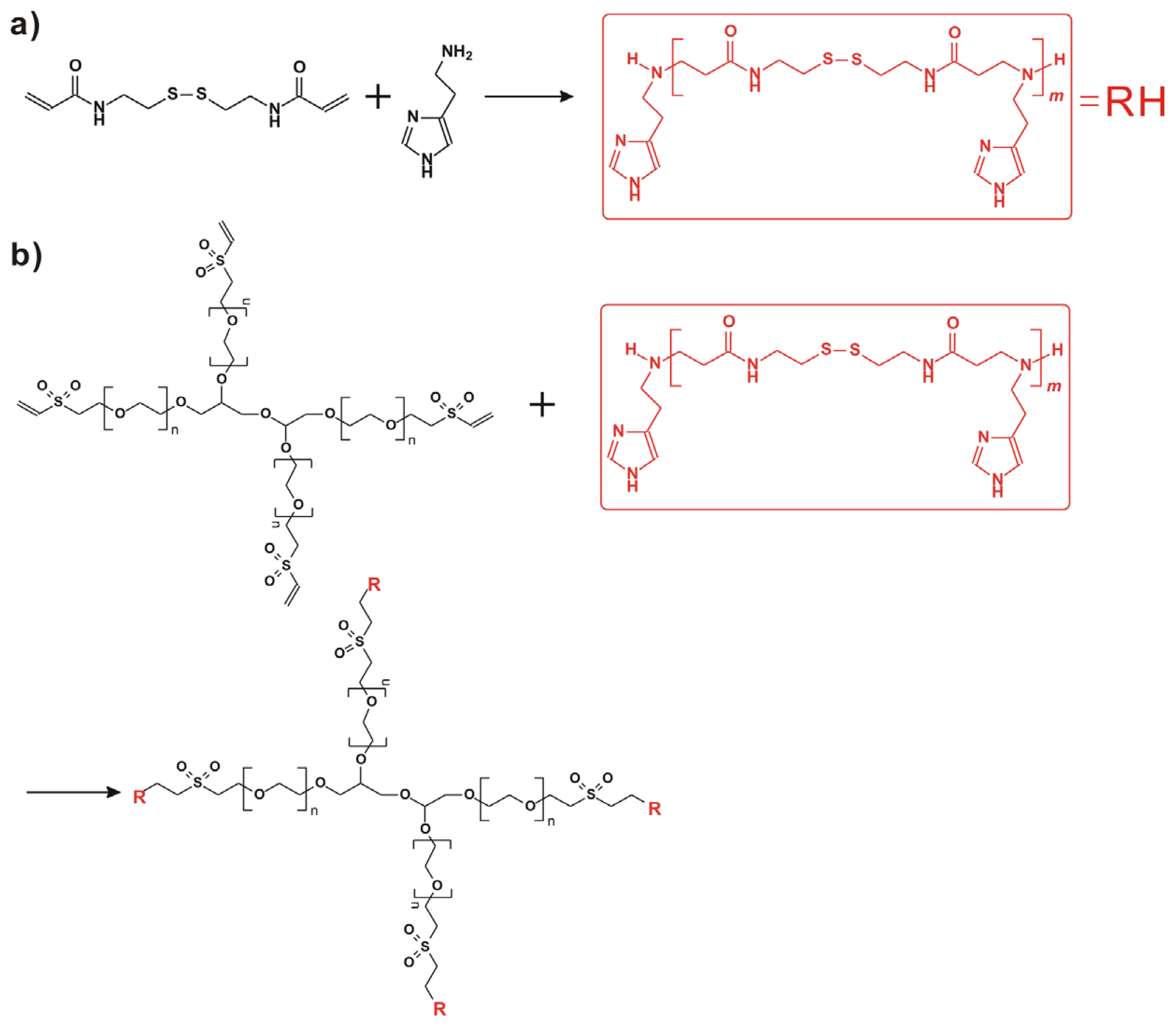
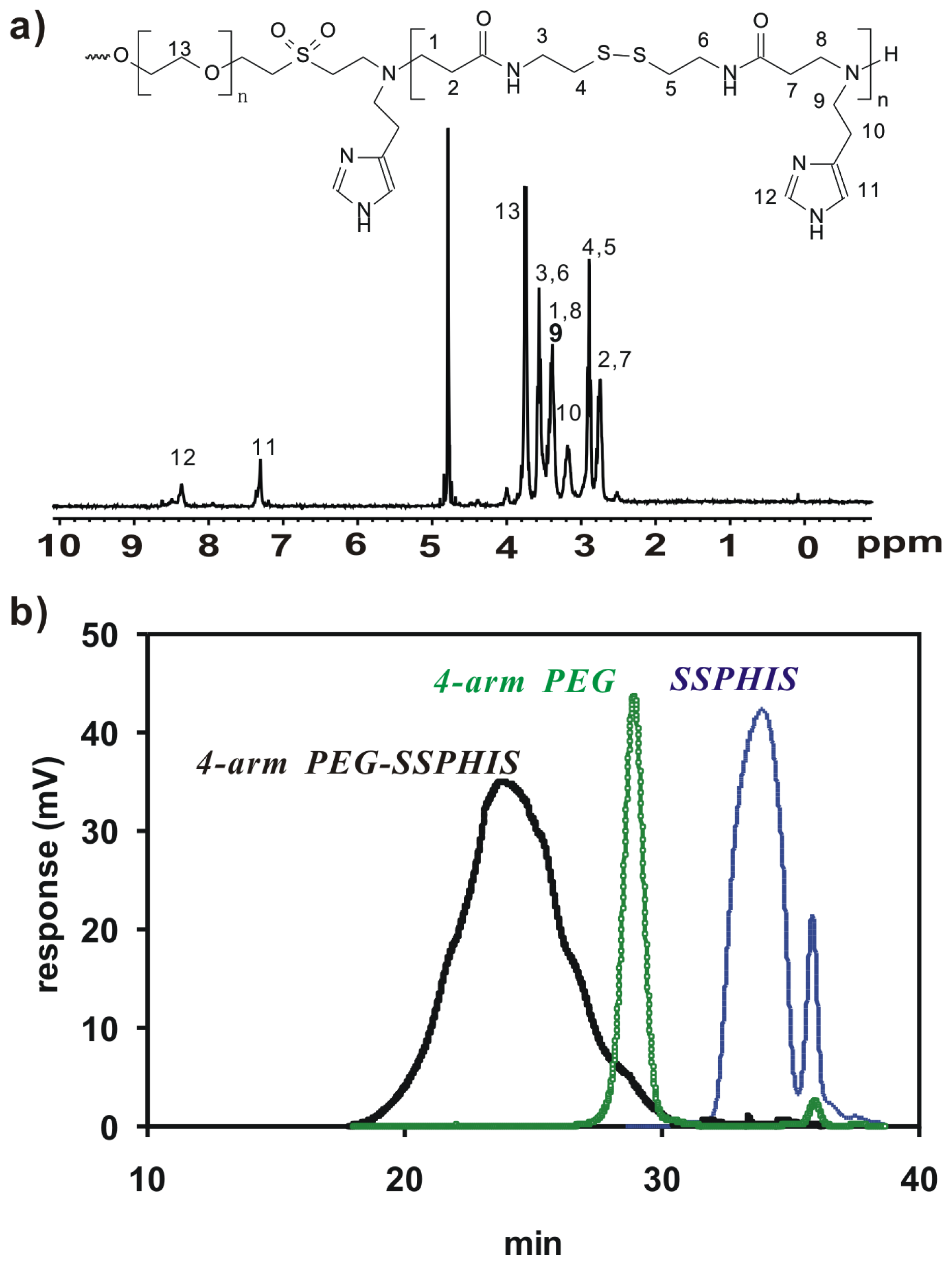

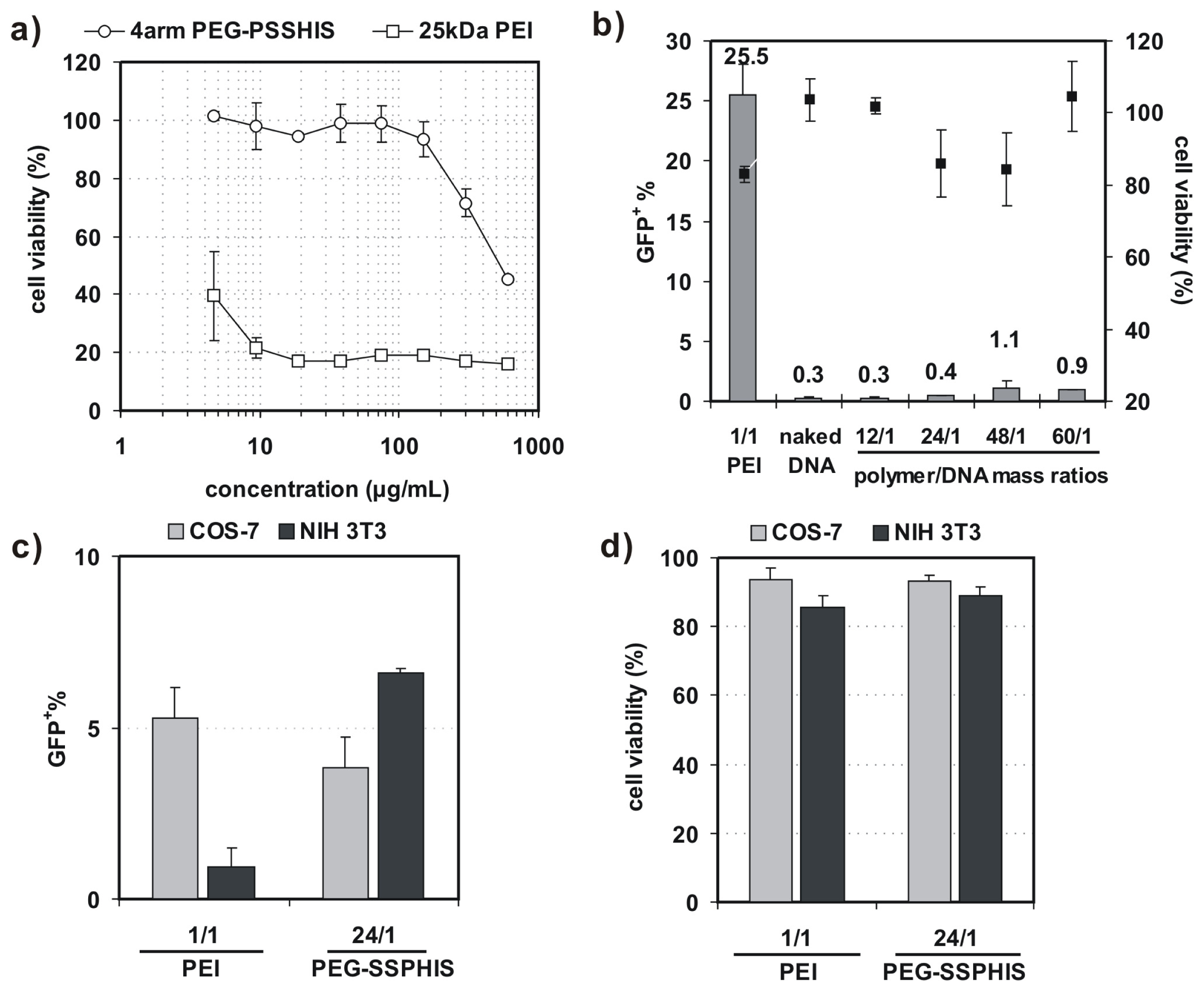


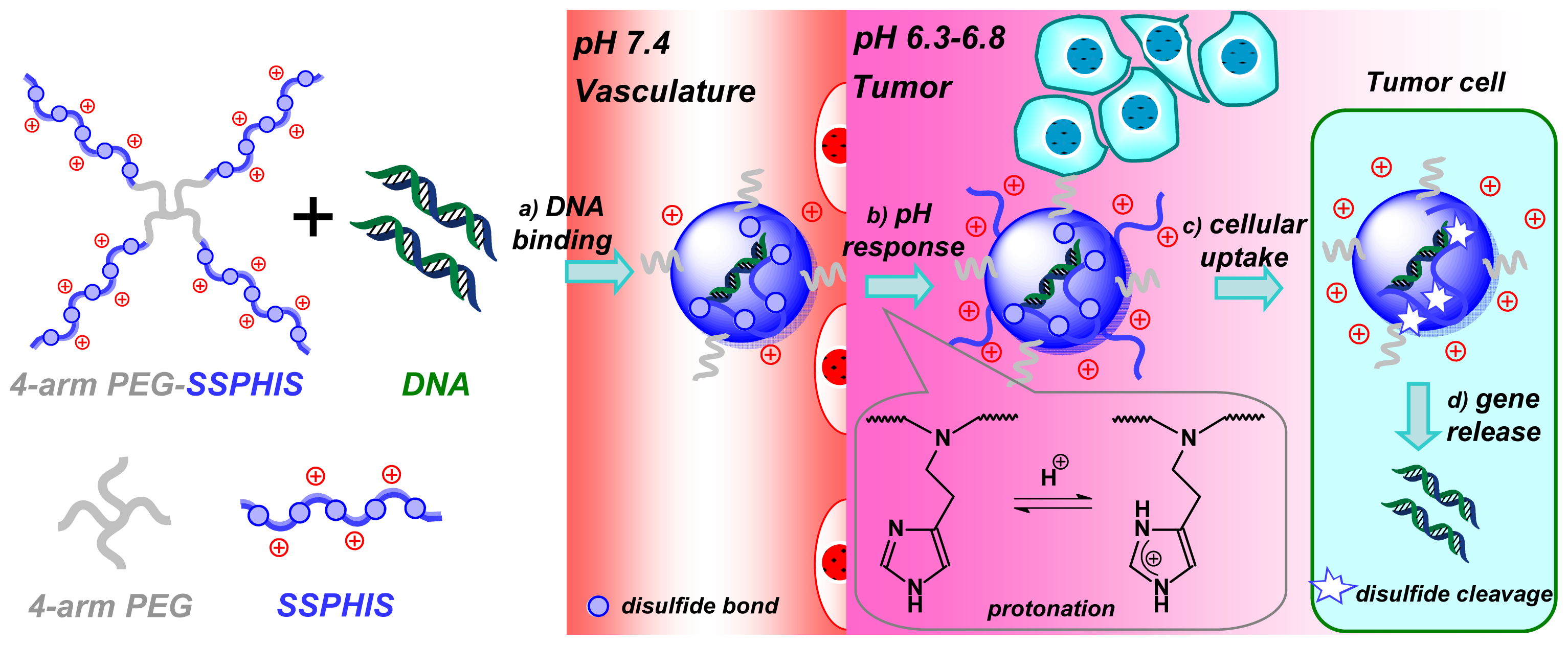
© 2014 by the authors; licensee MDPI, Basel, Switzerland This article is an open access article distributed under the terms and conditions of the Creative Commons Attribution license (http://creativecommons.org/licenses/by/3.0/).
Share and Cite
An, K.; Zhao, P.; Lin, C.; Liu, H. A pH and Redox Dual Responsive 4-Arm Poly(ethylene glycol)-block-poly(disulfide histamine) Copolymer for Non-Viral Gene Transfection in Vitro and in Vivo. Int. J. Mol. Sci. 2014, 15, 9067-9081. https://doi.org/10.3390/ijms15059067
An K, Zhao P, Lin C, Liu H. A pH and Redox Dual Responsive 4-Arm Poly(ethylene glycol)-block-poly(disulfide histamine) Copolymer for Non-Viral Gene Transfection in Vitro and in Vivo. International Journal of Molecular Sciences. 2014; 15(5):9067-9081. https://doi.org/10.3390/ijms15059067
Chicago/Turabian StyleAn, Kangkang, Peng Zhao, Chao Lin, and Hongwei Liu. 2014. "A pH and Redox Dual Responsive 4-Arm Poly(ethylene glycol)-block-poly(disulfide histamine) Copolymer for Non-Viral Gene Transfection in Vitro and in Vivo" International Journal of Molecular Sciences 15, no. 5: 9067-9081. https://doi.org/10.3390/ijms15059067



